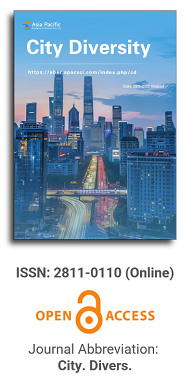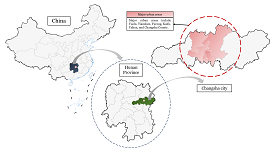
Asia Pacific Academy of Science Pte. Ltd. (APACSCI) specializes in international journal publishing. APACSCI adopts the open access publishing model and provides an important communication bridge for academic groups whose interest fields include engineering, technology, medicine, computer, mathematics, agriculture and forestry, and environment.

As China's pillar industry, the property market has suffered a considerable impact in recent years, with a decline in turnover and many developers at risk of bankruptcy. As one of the most concerned factors for stakeholders, housing prices need to be predicted more objectively and accurately to minimize decision-making errors by developers and consumers. Many prediction models in recent years have been unfriendly to consumers due to technical difficulties, high data demand, and varying factors affecting house prices in different regions. A uniform model across the country cannot capture local differences accurately, so this study compares and analyses the fitting effects of multiple machine learning models using February 2024 new building data in Changsha as an example, aiming to provide consumers with a simple and practical reference for prediction methods. The modeling exploration applies several regression techniques based on machine learning algorithms, such as Stepwise regression, Robust regression, Lasso regression, Ridge regression, Ordinary Least Squares (OLS) regression, Extreme Gradient Boosted regression (XGBoost), and Random Forest (RF) regression. These algorithms are used to construct forecasting models, and the best-performing model is selected by conducting a comparative analysis of the forecasting errors obtained between these models. The research found that machine learning is a practical approach to property price prediction, with least squares regression and Lasso regression providing relatively more convincing results.
Cultural diversity and educational policy in Chinese society
Vol 1, Issue 1, 2020
Download PDF
Abstract
With the rapid development of urbanization, modernization, information technology and globalization, cultural patterns are becoming more and more diverse and social groups are becoming more and more atomized. We need to re-examine cultural diversity and think about how education can promote cultural exchange and integration. Based on the concept of multicultural education, this paper analyzes the current situation of cultural diversity in Chinese society from the dimensions of urban and rural areas, nationalities, regions, social classes, gender and globalization. On this basis, it explains several core values of pluralistic and cultural education: achieving equity by teaching tolerance and recognition, reflecting on power relations and knowledge construction, pluralistic unity and cultural integration, and cosmopolitanism in the age of globalization. From the perspective of improving educational policies, it is proposed that cultural diversity should be recognized and recognized in educational policies and practices, and appropriate curriculum power and space should be given. Construct the flexible education policy that puts fairness first and quality equal; with the help of big data and information technology, we can construct accurate and personalized multicultural education.
Keywords
References
- FISCHER C. Toward a subcultural theory of urban-ism. American journal of Sociology 1975; 80(6): 1319–1341.
- BANKS J A. An introduction to multicultural edu-cation. 4th ed. Boston: Pearson/Allyn and Bacon 2008; p. 10.
- Wang J. Multicultural Education: The Practice of Western Minority Education and Its Enlightenment. Guangxi Ethnic Studies 2004; (1):112–117.
- Li C. The historical trend of educational inequality (1940–2010): A review of the inequality of educa-tional opportunities in urban and rural areas. Soci-ological research 2014; 29(2): 65–89+243.
- Li Y, Jia M, Zheng W, et al. Current situation and influencing factors of children’s early cognitive development in poor rural areas of China. Journal of east China normal university (education science edition) 2019; 37(3): 17–32.
- Department of Floating Population, National Health and Family Planning Commission. Report on the Development of Floating Population in China. Beijing: China Population Publishing House; 2015.
- Wang T. Culturally responsive curriculum and teaching for children with migrant families: the lens of multicultural education theory. Journal of east China normal university (education science edition) 2018; 36(5): 104–113+169.
- State Ethnic Affairs Commission. Challenges facing the Development of Ethnic Culture in China [EB/01]. (2013–08–26) [2019–06–24]. Available from: http://whxcs.Seac.gov.en/art/2013/8/26/ART_6885189412.html.
- Ma R. Some thoughts on minority education in China. Journal of xinjiang normal university (phi-losophy and social sciences edition) 2010; 31(1):6–18.
- LEIBOLD J, CHEN Y. Minority education in China: Balancing unity and diversity in an era of critical pluralism. Hong Kong: Hong Kong University Press; 2014; p. 13.
- Shanghai Education Publishing House. Explanation of changing “grandma” into “grandma” in the Chinese textbook of the second semester, Grade 2, Shanghai Education Press [EB/01]. (2018–06–21) [2019–06–24]. Available from: Http://www.seph.com.cn/newsdetail.aspx? Id = 137.
- Zong Y. Development of kindergarten–based cur-riculum based on regional culture. Preschool Edu-cation Research 2015; (9):70–72.
- Wang J. Research on local curriculum development in ethnic areas of China. Education Research 2006; (4):24–27.
- Li C. On the curriculum design of experiential moral education based on regional culture; A new per-spective of the comprehensive practical activity curriculum of “Cultural Life”. Curriculum, Text-books and Teaching Methods 2010; 30(7): 61–66.
- Cheng S. Cultural Interpretation of Teaching School Research: Taking Su School Education Research as an Example. Curriculum, Textbooks and Teaching Methods 2016; 36(5): 36–44.
- Yang D. Understanding and Thinking of Educa-tional Equity in China. Educational Development Research 2000; (8): 5–8.
- Wu K, Cheng X, Wu Y, et al. Sociological Research on Classroom Teaching. Educational Research 1997; (2): 64–71.
- Wu Y. Sociological Analysis of Classroom Teaching. Journal of Nanjing Normal University (Social Sci-ence Edition) 1992; (2): 114–117.
- Central Broadcasting Network. “Asia’s largest col-lege entrance examination factory”, Anhui Maotan Factory Middle School, has a mixed reputation [EB/01]. (2016–08–07) [2019–06–24]. Available from: Http://edu.people.com.cn/n//2015/0807/C244541
- Zhou Y. Poor students’ educational struggle and social rise: from the perspective of historical soci-ology. Journal of Nanjing Normal University (Social Science Edition) 2017; (4): 94–99.
- Lin X. “Buying Hope”: Children’s Educational Consumption in Urban Families. Sociological Re-search 2018; 33(4): 163–190+245.
- Wen J, Li S. The class difference of intergenerational transmission of cultural capital and its influence: A comparative study based on the middle class and working class families in Shanghai. Journal of East China Normal University (Philosophy and Social Sciences Edition) 2018; 50(4): 101–113+175.
- Phoenix Net. Mainland China’s population is ap-proaching the 1.4 billion mark, with 31.64 million more men than women [EB/01]. (2015–09–22) [2019–06–24]. Http://finance.ifeng.com/c/7JDFGVVADCZ.
- Information Office of the State Council of the Peo-ple’s Republic of China. White Paper on Gender Equality and Women’s Development in China in September 2015 [EB/01]. (2015–09–22) [2019–06–24]. Http://www.gov.cn/zhengce/2015–09
- Mycos Research Institute. Blue Book of Employ-ment: Employment Report of Chinese College Students in 2015 [R]. Beijing: Social Science Lit-erature Publishing House; 2015.
- Wan G. Religion–based cultural identity and con-straints of mighty Muslim students in northwestern China. Race E also Ni City and Education 2018; 21 (6): 858–875.
- BANKS J A, BANKS C A M G. Multicultural Edu-cation: Issues and Perspectives. 8th ed. Hoboken: John Wiley and Sons, Inc; 2013.
- GUTMANN A. Unity and diversity in democratic multi cultural education· Creative and destructive tensions [G]//BANKS J A, etc. Diversity and citi-zenship education: Global perspectives, San Fran-cisco: Jossey–Bass; 2004–71–96.
- STEELE C. Whistling Vivaldi: And other Clues to How Stereotypes Affect Us. New York: W. W. Norton & Company; 2010: 14.
- Wang Xueju. What does the rural background mean to them? One-by-one case study based on two rural college students. Youth Research 2007; (11): 16–23.
- Yu Xiulan. Analysis of urban bias in teaching con-tent in primary and secondary schools: Taking Chinese textbooks as an example. Journal of Nan-jing Normal University (Social Science Edition) 2005; (5): 91–97.
- Yu X. Urban Bias in the College Entrance Exami-nation: An Analysis of the Chinese Test Papers in the College Entrance Examination in Ten Years. Edu-cation Theory and Practice 2004; (2): 40–43.
- Hong Jun, Qiana Er. Curriculum Imbalance: Mul-ticultural Analysis of Rural School Curriculum in Minority Areas. Journal of Northeast Normal Uni-versity (Philosophy and Social Sciences Edition), 2008; (1): 34–39.
- BALDWIN J. A talk to teachers [EB/01]. (2015-02- 16) [2019-06-24]. http://richgibson. com/talk toteachers. htm.
- GONZÁLEZ N, MOLL L, AMANTI C. Funds of Knowledge: Theorizing Practices in Households, Communities, and Classrooms. New Jersey: Law-rence Erlbaum Associates Incorporated; 2005.
Supporting Agencies
Copyright (c) 2020 Tao Wang

This work is licensed under a Creative Commons Attribution 4.0 International License.

This site is licensed under a Creative Commons Attribution 4.0 International License (CC BY 4.0).

Prof. Mehmet Cetin
Kastamonu University,
Turkey
Polish Scientific Bibliography

